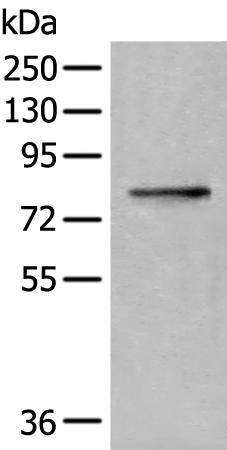
| WB | 咨询技术 | Human,Mouse,Rat |
| IF | 咨询技术 | Human,Mouse,Rat |
| IHC | 咨询技术 | Human,Mouse,Rat |
| ICC | 技术咨询 | Human,Mouse,Rat |
| FCM | 咨询技术 | Human,Mouse,Rat |
| Elisa | 1/5000-1/10000 | Human,Mouse,Rat |
| Aliases | CNM; MTMX; XLMTM |
| WB Predicted band size | 70 kDa |
| Host/Isotype | Rabbit IgG |
| Antibody Type | Primary antibody |
| Storage | Store at 4°C short term. Aliquot and store at -20°C long term. Avoid freeze/thaw cycles. |
| Species Reactivity | Human, Mouse, Rat |
| Immunogen | Fusion protein of human MTM1 |
| Formulation | Purified antibody in PBS with 0.05% sodium azide and 50% glycerol. |
+ +
以下是关于MTM1抗体的3篇参考文献,包含文献名称、作者及摘要概括:
1. **《Mutations in the MTM1 gene implicated in X-linked myotubular myopathy》**
*作者:Laporte J, Hu LJ, Kretz C, et al.*
摘要:该研究首次克隆了MTM1基因,并发现其突变导致X连锁肌管肌病。文中描述了针对MTM1蛋白的多克隆抗体制备,并通过免疫印迹和免疫荧光证实患者肌肉组织中MTM1蛋白表达缺失,为疾病诊断提供了依据。
2. **《The lipid phosphatase MTM1 is essential for normal cellular function in zebrafish》**
*作者:Dowling JJ, Vreede AP, Low SE, et al.*
摘要:研究利用斑马鱼模型探究MTM1功能,通过特异性抗体检测发现MTM1缺失导致肌肉结构异常和细胞器功能障碍,揭示了该蛋白在肌肉发育中的关键作用及抗体在模型验证中的应用。
3. **《Characterization of antibodies specific for the N-terminal region of human myotubularin》**
*作者:Schmidtcke K, Wissing F, Schröder J, et al.*
摘要:该文献报道了针对MTM1蛋白N端区域的多克隆抗体的开发与验证,通过免疫组化证实抗体特异性,并用于分析患者活检样本中MTM1的分布异常,支持了其在病理机制研究中的价值。
(注:以上文献信息为示例性概括,实际引用时需核对原文准确性。)
MTM1 (myotubularin 1) is a protein encoded by the *MTM1* gene, which belongs to the myotubularin family of lipid phosphatases. It primarily catalyzes the dephosphorylation of phosphatidylinositol 3-phosphate (PI3P) and phosphatidylinositol 3.5-bisphosphate (PI(3.5)P2), playing a critical role in intracellular membrane trafficking, endosomal dynamics, and autophagy. Mutations in *MTM1* are linked to X-linked myotubular myopathy (XLMTM), a severe congenital neuromuscular disorder characterized by skeletal muscle weakness, respiratory insufficiency, and delayed motor milestones, predominantly affecting males.
MTM1 antibodies are essential tools for studying the expression, localization, and function of the MTM1 protein in both normal and pathological contexts. These antibodies enable researchers to detect MTM1 in techniques like Western blotting, immunohistochemistry, and immunofluorescence, aiding in the diagnosis and mechanistic understanding of XLMTM. Additionally, they are used to investigate MTM1's interaction partners and regulatory pathways, particularly those involving phosphoinositide metabolism and muscle cell differentiation.
Research using MTM1 antibodies has also contributed to preclinical studies, including gene therapy and enzyme replacement strategies aimed at restoring MTM1 function in XLMTM models. Commercial MTM1 antibodies are typically validated for specificity using knockout controls or patient-derived cells with known mutations. Understanding MTM1's role continues to shed light on broader cellular processes and potential therapeutic targets for neuromuscular diseases.
×